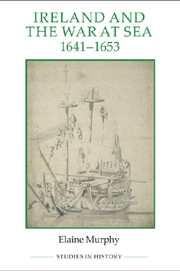Book contents
- Frontmatter
- Contents
- List of figures, maps and tables
- Acknowledgements
- Abbreviations
- Glossary
- Map 1 Ireland, 1641–9: principal ports and locations
- Map 2 The British Isles, 1641–9: principal ports and locations
- Map 3 The British Isles and Europe, 1641–9: principal ports and locations
- Introduction
- PART I The War at Sea, 1651–1653
- 1 The outbreak and spread of the rebellion, October 1641–September 1643
- 2 ‘Weathering the storm’, September 1643–July 1646
- 3 ‘Infested with pirates’, August 1646–August 1649
- 4 The support of the navy, September 1649–April 1653
- Part II Navies and the Conduct of the War at Sea
- Appendices
- Bibliography
- General index
- Index of ships
3 - ‘Infested with pirates’, August 1646–August 1649
from PART I - The War at Sea, 1651–1653
Published online by Cambridge University Press: 05 April 2013
- Frontmatter
- Contents
- List of figures, maps and tables
- Acknowledgements
- Abbreviations
- Glossary
- Map 1 Ireland, 1641–9: principal ports and locations
- Map 2 The British Isles, 1641–9: principal ports and locations
- Map 3 The British Isles and Europe, 1641–9: principal ports and locations
- Introduction
- PART I The War at Sea, 1651–1653
- 1 The outbreak and spread of the rebellion, October 1641–September 1643
- 2 ‘Weathering the storm’, September 1643–July 1646
- 3 ‘Infested with pirates’, August 1646–August 1649
- 4 The support of the navy, September 1649–April 1653
- Part II Navies and the Conduct of the War at Sea
- Appendices
- Bibliography
- General index
- Index of ships
Summary
From the autumn of 1646 a shift can be noticed in the nature of the war in the seas around Ireland. An escalation of naval activity took place on both the confederate and parliamentarian sides, Irish privateers and prizes can be more readily identified than in previous years, and numerous contemporary English reports lamented that the Irish coast was ‘infested with pirates’. At the same time the parliamentary naval effort increased with larger squadrons and newly-constructed frigates dispatched to Ireland. Rather than simply supporting coastal enclaves these ships actively patrolled the seas in pursuit of Irish frigates and merchantmen. The intensification of the maritime conflict led to levels of naval action and prize-taking not seen previously in the war.
August 1646–December 1647
Following the fall of Dunkirk to the French in October 1646, the levels of privateering activity that can be detected in Ireland increased dramatically. With the loss of their base in Flanders, many frigate captains chose to transfer their operations to Waterford and Wexford. Victories at Duncannon in 1645 and Bunratty in June 1646 also helped to demonstrate to foreign privateers that the confederates possessed the military capability to ensure that their harbours remained accessible. A report in November 1646 claimed that these two Irish harbours swarmed with Dunkirkers. Increased numbers of confederate privateers and prizes can be identified in 1647. Records indicate that nine men-of-war seized at least fifty-one prizes.
- Type
- Chapter
- Information
- Ireland and the War at Sea, 1641–1653 , pp. 53 - 68Publisher: Boydell & BrewerPrint publication year: 2012

